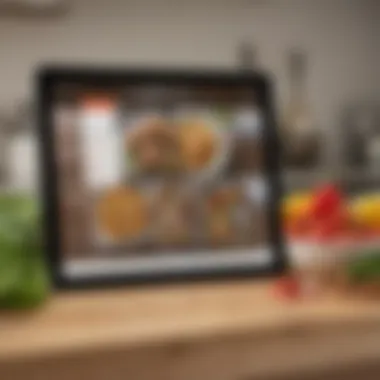Discover the Best Weekly Menu Planner Apps


Intro
In today's fast-paced world, meal planning has become an essential aspect of modern life. The need for efficiency in the kitchen has led to the rise of various digital tools designed to simplify the process. Among these tools, weekly menu planner apps stand out by offering users the ability to organize their meals and streamline grocery shopping. This comprehensive overview will explore the best weekly menu planner apps by examining their features, user interfaces, and how they integrate with grocery delivery services.
With technology shaping our cooking habits and food consumption, these applications provide culinary enthusiasts with the opportunity to tailor their cooking experiences to their specific needs. This article aims to offer valuable insights for those who seek to optimize their meal preparation processes, whether they are seasoned cooks or novices.
Key Features of Weekly Menu Planner Apps
When choosing a menu planner app, users should consider several key features that enhance usability and maximize efficiency.
- User Interface: An intuitive and user-friendly interface is crucial for effective meal planning. Users should be able to navigate the app easily, allowing for quick access to various functionalities.
- Customization Options: A strong app should allow users to personalize their meal plans according to dietary preferences, such as vegetarian, gluten-free, or keto diets.
- Grocery Integration: The best apps often feature direct links to grocery delivery services or allow users to create shopping lists. This connection enhances efficiency and ensures that ingredients can be acquired with ease.
- Recipe Database: A comprehensive recipe library is a must, offering users a diverse selection of dishes to incorporate into their weekly plans.
- Nutritional Tracking: Some applications help users monitor calories and other nutritional information, catering to health-conscious cooks.
These features significantly impact user experience and can influence the success of meal preparation efforts.
Impact on Cooking Habits
The adoption of weekly menu planner apps has made a noticeable impact on cooking habits. By simplifying the process of planning meals, these apps can encourage individuals to cook more at home and explore new recipes. With a well-structured menu, users can better manage their time and resources, leading to less food waste and healthier eating choices.
Additionally, apps that cater to specific dietary requirements play an important role in supporting health and wellness. They allow users to easily find recipes that meet their individual needs while keeping meal variety at the forefront.
Ending
Understanding the scope of features offered by weekly menu planner apps is essential for anyone looking to enhance their culinary journey. By combining user preferences with technology, these applications empower users to take charge of their meal preparation, leading to more satisfying and enjoyable cooking experiences. As the digital landscape continues to evolve, the potential of these tools will undoubtedly expand, offering even more innovative solutions to the challenges of daily cooking.
Preamble to Menu Planning
In today's fast-paced world, meal planning becomes essential for maintaining a healthy lifestyle. A structured approach to organizing meals can significantly simplify the cooking process and improve nutrional choices. Traditional methods of planning often lead to stress, disorganization, and last-minute decisions that may compromise dietary goals. This is where the importance of menu planning comes into play.
Through effective meal planning, individuals can ensure they have the necessary ingredients on hand, reducing food waste and minimizing the need for impulsive purchases. Additionally, a clear menu allows for better portion control, which can lead to healthier eating habits. As the culinary landscape continues to evolve, embracing technology can offer valuable assistance in streamlining these processes.
Importance of Meal Planning
Meal planning offers several benefits that cater to various aspects of daily life. To begin, it fosters better eating habits by allowing individuals to craft balanced meals. This is particularly advantageous for those aiming for specific dietary requirements or restrictions. With a week’s worth of meals planned, it is easier to incorporate a variety of nutrients and food groups.
Moreover, meal planning saves time. Rather than pondering daily what to eat, knowing in advance can streamline shopping and cooking routines. It reduces visits to the grocery stores, conserving time and financial resources. Ultimately, meal planning minimizes stress. Knowing what to prepare reduces the mental load typically associated with daily cooking decisions.
Another critical aspect lies in the potential for family involvement. When planning a menu, family members can contribute ideas, which encourages shared cooking experiences and promotes healthier eating habits for children.
Overview of Menu Planning Apps
With the rise of digital technology, various menu planning apps have emerged, aiming to simplify meal preparation. These applications provide an intuitive way to organize recipes, generate shopping lists, and even monitor nutritional intake. Users appreciate the ability to select meals based on dietary preferences or restrictions, making it easier to adhere to specific eating plans.
Many of these apps include features such as recipe collections, nutrition tracking, and even meal prep tutorials. Additionally, some have functionalities that allow integration with grocery delivery services, enhancing convenience further. In essence, menu planning apps serve as a valuable tool that fosters organization in the kitchen and supports healthier culinary choices.
"The right meal planning app can transform how you approach cooking, making it more efficient and enjoyable."
As we continue to explore these applications, understanding their features and benefits will allow readers to make informed decisions that align with their unique eating habits and lifestyle choices.
Criteria for Evaluating Meal Planner Apps


Choosing the right meal planner app is essential for enhancing your culinary experience and optimizing meal preparation. Selecting a suitable platform requires consideration of various criteria that play a crucial role in ensuring that the app meets individual needs and preferences. In this section, we discuss three fundamental aspects: User Interface Design, Customization Features, and Accessibility and Compatibility, which form the basis for evaluating meal planner applications.
User Interface Design
A well-crafted user interface serves as the first point of contact for users exploring a meal planner app. The design should prioritize simplicity and intuitiveness, allowing users to navigate effortlessly. Important elements to look for include clear menus, logical categorization of options, and visually appealing layouts. A confusing interface can deter users, making meal planning feel more like a chore rather than an enjoyable activity.
Moreover, responsive design across devices is pivotal. Many individuals switch from smartphones to tablets or computers. A seamless experience on all platforms enhances user satisfaction. If you encounter an app that feels clunky or difficult to operate, it may be best to seek alternatives.
Customization Features
Customization features significantly influence a user’s ability to tailor meal planning according to dietary preferences and culinary styles. A robust meal planner should offer various options, such as dietary restrictions, calorie limits, and cuisine types. Users appreciate the ability to create personalized meal plans that align with their health goals, whether that be weight loss, muscle gain, or injury recovery.
Additionally, features like recipe integration and the ability to add personal notes create a more engaging experience. Users should be able to adjust portion sizes or swap ingredients according to what they have at hand. This flexibility not only enhances meal preparation but also fosters creativity in cooking.
Accessibility and Compatibility
Accessibility and compatibility are crucial factors, especially in a multi-device world. A meal planner app should be available across various platforms, such as iOS, Android, and web browsers. Evaluating an app's capability to sync information across devices can save time and prevent frustration. The lack of cross-platform support often limits users to a single device, which can be impractical.
Furthermore, consider how the app accommodates users with specific needs, such as voice recognition for hands-free usage or compatibility with assistive technologies. By prioritizing inclusivity in design, meal planner apps can ensure that all individuals can enjoy their benefits.
"User-centric design and robust features are vital for anyone serious about meal planning."
In summary, the criteria for evaluating meal planner apps encompass user interface design, customization features, and accessibility. Each of these elements contributes to the overall usefulness and satisfaction derived from the app. Taking the time to assess them will ultimately lead to a better meal planning experience.
Top Weekly Menu Planner Apps
In the sphere of meal preparation, the selection of the right app can significantly influence not only the efficiency of cooking but also the enjoyment derived from it. Choosing a top weekly menu planner app is critical for several reasons. First, the right application can simplify grocery shopping by syncing with local grocery delivery services. Second, these apps often provide valuable recipe suggestions tailored to your dietary preferences, which helps in maintaining a balanced diet. Lastly, they can enhance organization in the kitchen, reducing food waste through effective inventory management.
Selecting the best planner can be straightforward, provided one knows what to look for. Various apps offer unique features and functionalities, helping users to create personalized meal plans. Thus, understanding these offerings is pivotal for making informed choices that cater to individual cooking habits and lifestyle preferences.
App One: Overview and Features
App One, known as Mealime, is tailored for individuals seeking speed and simplicity. It offers an intuitive interface that guides users through meal preparation step-by-step. Mealime emphasizes personalization; users can set their dietary restrictions and preferences. This ensures that recipes generated fit their unique profile. Additionally, it offers grocery list functionalities, which allow users to compile all ingredients neatly for easy shopping.
The app's primary features include:
- Customized Meal Plans: Users receive plans tailored to preferences.
- Quick Preparation Time: Most recipes are designed to be ready in under 30 minutes.
- Nutrition Information: Users can track nutritional content easily.
App Two: Overview and Features
App Two, called Paprika, stands out for its recipe management capabilities. Users can save recipes from various sources, allowing flexibility in meal planning. Paprika allows the user to create meal plans and automatically generates grocery lists based on the selected recipes. Its strong organizational features make it easy for users to categorize, edit, and search for recipes.
Notable features of Paprika include:
- Recipe Importing: Users can import recipes from websites.
- Pantry Tracker: The ability to input current inventory helps in planning meals without waste.
- Cross-Device Synchronization: The app syncs across multiple devices, ensuring access anywhere.
App Three: Overview and Features
App Three, called Plan to Eat, focuses on the planning process itself. Users can drag and drop recipes into a calendar, making it straightforward to visualize meals over the week. The user interface is clean, facilitating easy navigation. Plan to Eat also resonates well with families, as it allows for sharing meal plans among multiple users.
Key features of Plan to Eat are:


- Calendar Integration: Visualizes meal prep over the week or month.
- Recipe Scaling: Adjust portions for larger or smaller servings as needed.
- Community Recipes: Access to a library of recipes shared by other users.
App Four: Overview and Features
App Four, Fresh EBT, focuses heavily on budget-conscious meal planning. It assists users in managing their food spending while still enabling effective meal management. Users can track their EBT balance, and the app suggests meals based on available funds, making it specifically useful for low-income households. Its practical features include:
- Budget Meal Planning: Recipes designed with cost in mind.
- Shopping List Generation: Automatically generate shopping lists based on planned meals.
- Weekly Budget Overview: Track spending through designed tools.
App Five: Overview and Features
App Five, called Yummly, integrates smart technology to enhance meal prep. Utilizing AI, the app suggests recipes based on the user’s previous selections and ingredients on hand. It also connects with grocery stores for online shopping.
Yummly’s strengths include:
- Personalized Recipe Suggestions: Adjusts recommendations based on user-specific data.
- Ingredient Search and Filtering: Quickly find recipes based on specific ingredients or preferences.
- Integrated Grocery Delivery: Facilitates seamless ordering of ingredients needed for selected recipes.
This exploration of top weekly menu planner apps highlights how they can significantly change meal preparation. By utilizing these tools, users can enhance their culinary experience through better planning and vibrant meal selections.
Advanced Features in Menu Planner Apps
Advanced features in menu planner apps are critical to enhancing the meal planning experience. As users seek greater efficiency and personalization, these applications must go beyond basic functionalities. They should integrate seamless options to meet diverse dietary requirements and lifestyle choices. Having advanced features can not only make meal planning simpler but also transform it into a more enjoyable process.
Integration with Grocery Delivery Services
One of the most significant advancements in menu planner apps involves integration with grocery delivery services. This feature allows users to schedule their grocery shopping based on their selected meal plans. For example, if a user plans to make a pasta dish on Wednesday, the app can automatically generate a grocery list that includes all necessary ingredients.
More importantly, when linked to grocery delivery services, users can have their shopping done with a single click. This convenience is especially valuable in today’s fast-paced environment, where time-saving solutions are highly sought after.
Users report that having groceries delivered reduces the hassle of last-minute shopping trips. Also, it encourages users to stick to their meal plans, as everything they need arrives at their doorstep. Users should assess the grocery partners available with specific apps ensuring that their local grocery options are covered.
Smart Suggestions and AI Integration
The role of artificial intelligence in menu planner apps cannot be overstated. Smart suggestions enhance the user experience by offering meal ideas based on preferences, dietary restrictions, and past selections. For instance, if a user frequently includes gluten-free recipes in their meal plans, the app's AI can prioritize similar recipes in future suggestions.
Furthermore, the predictive capabilities of AI can assess seasonal ingredients and provide recommendations that maximize freshness and nutritional value. This aspect ensures that meal planning is not only efficient but also aligned with current trends, seasonal produce, and health guidelines.
However, users must carefully consider the limitations of AI-generated suggestions. It’s possible that some recommendations may not suit an individual’s unique tastes or needs. Therefore, it is important for users to provide feedback on suggestions so that the app refines its algorithms over time.
"The ability for menu planner apps to learn user preferences can significantly enhance meal planning efficiency and satisfaction."
User Reviews and Insights
User reviews provide crucial perspectives on any meal planner app. These reviews reflect real-world usage, allowing potential users to gauge the effectiveness, practicality, and overall satisfaction associated with different applications. Understanding user insights is indispensable in identifying both strengths and weaknesses of each app, guiding decisions for those seeking the right fit for their cooking and meal preparation needs.
Reviews often highlight key factors such as ease of use, feature functionality, and overall user satisfaction. As the landscape of meal planning apps becomes more competitive, users take to various platforms to share their experiences. This feedback can either validate or deter interest in a product. For instance, an app with a strong user base often demonstrates successful user onboarding and satisfaction.
Overall, turning to the user community not only aids in the selection process but also unveils common practices and pitfalls that users encounter. It offers a glimpse into daily usage that product descriptions alone cannot capture. Evaluating user reviews reveals insights about usability, ongoing performance, and customer support services, all of which are essential elements in choosing the right app for one’s culinary tasks.
User Experience and Satisfaction
User experience is a fundamental component of any application’s appeal. When planning meals, smooth navigation through the app can significantly impact users’ willingness to engage with it regularly. A clear interface, with easily accessible features, often correlates with higher satisfaction levels. Many successful meal planner apps integrate intuitive design principles that resonate with users, allowing them to focus on meal planning instead of struggling with complex functionalities.


Most users appreciate features such as drag-and-drop menu creation, simple recipe searches, and seamless grocery list generation. Positive experiences often encourage regular use, contributing to better meal planning habits over time. Users who report satisfaction also highlight personal customization features that allow them to tailor meal plans according to dietary restrictions and preferences.
Conversely, if a user finds an app cumbersome or unintuitive, the chances of abandonment increase. Therefore, the overall user experience metrics, including user retention rates, are a strong indicator of an app's success.
Common Issues Identified by Users
Despite the advantages of many meal planner apps, users often encounter various challenges. Common issues tend to stem from bugs, insufficient integration with grocery delivery services, or lack of diverse recipe options. Such shortcomings lead to frustrating experiences, especially when users expect a seamless planning process.
For instance, a widely reported issue among users is the lack of personalized meal suggestions based on previous preferences. Many apps may fall short in accurately analyzing dietary habits, leading to repeated suggestions that do not cater to individual tastes. Additionally, some functionality bugs may emerge during updates, which can disrupt established meal planning routines, frustrating users further.
Moreover, inadequate customer support can exacerbate issues when users seek resolutions or clarifications on functionalities. Prompt and helpful customer service is crucial in enhancing user satisfaction. When users express feelings of neglect or that their concerns are not addressed timely, it negatively impacts their overall experience.
For these reasons, examining user reviews is critical for learning about potential red flags and aligning expectations before committing to an app. Understanding common issues allows for informed decision-making and setting realistic expectations.
"Acknowledging user experiences not only illuminates the path for potential users but ultimately serves to guide developers in refining their products."
Engaging with user reviews empowers culinary enthusiasts to choose wisely among the myriad of meal planning apps available today.
The Future of Menu Planning Apps
Understanding the future of menu planning applications is crucial for both developers and users. As technology continues to advance, these apps are evolving in ways that promise to improve user experience within meal preparation and planning. The importance of this topic lies in preparing users for the upcoming features and trends that will redefine their culinary routines.
Trends in Technology and Meal Planning
In recent years, there has been a noticeable shift in how technology is integrated into food preparation. Here are some trends shaping the landscape of menu planning apps:
- Increased Personalization: Users are looking for customized meal plans that suit their dietary needs and preferences. The future will likely bring algorithms that analyze consumption data to provide tailored meal ideas.
- Voice Activation: As smart home devices become commonplace, integrating voice commands into menu planning apps can streamline the cooking process. Users may operate these apps hands-free, enhancing efficiency during meal prep.
- Health Integration: Future apps are likely to link with health devices. This can help users track their nutrition closely, ensuring meals align with fitness goals or medical requirements.
- AI-Driven Recommendations: Expect advancements in AI which can predict meal choices based on past behavior and preferences. This technology could enhance user engagement by suggesting recipes just when users want them.
These trends aim to make meal planning not just easier but smarter, adapting to individual lifestyles and transforming culinary experiences.
Potential Innovations on the Horizon
Looking ahead, several innovations could emerge in the realm of menu planning applications. These ideas may revolutionize how users engage with cooking and meal preparation:
- Augmented Reality (AR): Imagine an app that uses AR to show users step-by-step cooking instructions overlaid on their kitchen. This could make even complex recipes more accessible.
- Blockchain for Nutrition Transparency: The adoption of blockchain technology could offer users clarity concerning food sources and nutritional value. This transparency could cultivate trust and enhance user experience.
- Collaborative Meal Planning: Future apps might provide features that allow multiple users to create and share meal plans in real-time. This can be ideal for families or roommates trying to coordinate meals efficiently.
- Smart Kitchen Integration: As smart appliances gain popularity, newer apps may connect seamlessly with these devices. This integration would allow users to automate cooking processes, further reducing preparation time.
"The future of menu planning apps is rooted in the trajectory of technology and customer demand, aiming for seamless integration into daily life."
While these innovations are not yet mainstream, they highlight the direction of future developments in the culinary tech space.###
Finale
The conclusion section draws together the various insights and key points discussed throughout the article about menu planning apps. Understanding the importance of effective meal planning is vital for improving not only efficiency but also enjoyment in cooking. Digital meal planners help streamline the complex task of organizing meals, reduce food waste, and save time.
Final Thoughts on the Importance of Planning
Meal planning serves as a cornerstone in establishing healthy eating habits. It allows individuals to define their dietary goals and culinary preferences. As noted, the right app can make this process considerably smoother. Users can gain access to customized meal suggestions, which align with their lifestyle choices. This personalization can lead to better nutritional outcomes.
Moreover, planning meals ahead has economic advantages. It encourages bulk buying, which can reduce grocery costs. Additionally, having a clear menu avoids impulse purchases, helping individuals stick to their budget.
The integration of features like grocery delivery and smart suggestions signifies a remarkable shift in how we approach cooking and meal preparation. Such advancements make healthy eating more accessible, even for those with busy lifestyles or specific dietary restrictions.
As the landscape of menu planning apps evolves, embracing these tools will be increasingly significant for food lovers. This engagement not only enhances the cooking experience but also fosters a sense of culinary creativity. In a world where time is precious, the thoughtful use of meal planning apps can make every culinary adventure more enjoyable.
"The key to thriving in the culinary world is preparation. A solid plan can make all the difference in achieving your meal goals efficiently."
Ultimately, the apps discussed are more than just tools; they represent a shift in culinary culture. By leveraging technology, individuals are empowered to take control of their meal planning journeys. This article has highlighted essential aspects and considerations, making it easier for readers to make informed choices.



